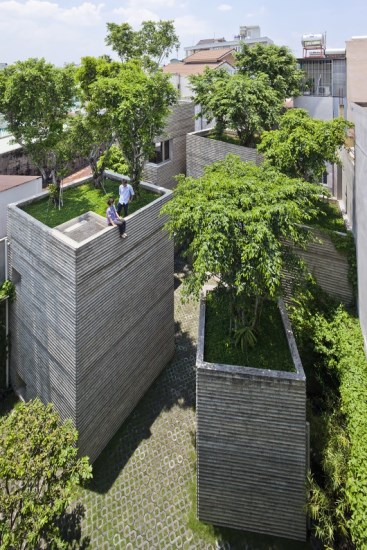Nghia, 38, from central Quang Binh Province, has won many international awards for his environmentally friendly architecture, and it is the desire to give something back to nature that drives his work.

Architect Vo Trong Nghia
A graduate of Japan's Nagoya University of Technology in 2002 and with an MA from study at Tokyo University in 2004, Nghia won the SPEC Go Green Award in 2014 for the “FPT University” project by the Vietnam Architectural Association. His Stacking Green won first prize at the Fifth AR House Awards 2014 for Green Design, he won the Gold Medal at last year's World Architecture Festival, and was named ArchDaily's Architecture of the Year.

Bamboo Wing

Wind and Water Bar
Nghia's conference hall at Dai Lai garnered prizes at the International Architecture Awards in 2013, while his Bamboo Wing won in the International Architecture Awards in 2011, and his Wind and Water Cafe won the Arcasia Award for 2007-08. Bamboo Wing also won the Gold Medal in the Resort Building category as well as the highest Bulding of the Year.
He recently spoke to DTiNews about his accomplishments and his vision.
Where do your creative ideas come from?
I think that creativity stems from a silent mind -- when our mind is in silence, we are able to connect with nature and clearly understand natural and social issues. Many consider my architectural works original, but they were made based on simple questions about simple problems in the life. I do not intentionally create discrepancy, but the simplicity of the work creates unique values on their own.

Stacking green
All of your works are energy-saving and close to nature. Why do you choose to create works in such styles?
Human beings are always close to the nature in their subconscious. I do think that it’s essential for everyone in the world to save energy and be environmentally friendly for sustainable existence as we consume too much and waste too much. It’s an obvious and indispensable task for architects to return as much green as possible to the earth.
Even though you studied architecture in Japan, you’ve applied several Vietnamese traditional natural materials and created unique works for Vietnam. What attracts you to typically Vietnamese works?
During the time I was studying in Japan I developed a Japanese mentality, in essence finding simple solutions to complicated problems. When I returned to Vietnam, I applied this to the practical environment, the climate, human and social circumstances, so I could create typically Vietnamese works that help deal with immanent issues in the country.

Communities Hall at Diamond Island in HCM City
In your view, why are your architectural works highly appreciated by international architects?
My works are simple and help deal with pressing issues in modern life. For example, as Hanoi and HCM City lack trees due to fast urbanisation, we’ve created works that feature a lot of trees. We’ve also made ceaseless efforts to call on authorities in big cities to issue regulations legalising green rooftops in urban areas. I do think that not only architects, but people working in any industry should look directly at pressing issues and work out direct solutions to improve the situation.
What messages are you trying to communicate to the next generation?
I think it’s really import to understand yourself and know who you are. I often wonder how much I have polluted the environment via the use of means of transportation, daily food consumption and personal needs. I have become aware that I’m nothing special in the world and I need to try more to make a better life, not just for me but for everyone.

House for trees
You’ve just published the book Vo Trong Nghia Architects. What is its central message?
The book is a collection of my green works in urban areas, as well as works close to nature. I do hope that they could be helpful references for people to create their own buildings.
If you had a chance to do something in Hanoi, what would you do?
I think that everything should be of itself and people should not try to create something just to attract attention. Many people often struggle to create an identity, but I do think that when an architectural work matches with its environment, social development, human interests and can become part of a people’s lifestyle, it assumes its own identity. An architectural work that is naturally acknowledged by many people and popular among the communities automatically attracts attention, no matter how big or small it is. But in order to improve the scenery of Hanoi, it’s necessary to grow more green trees and work out clearer planning for this. It’s not really difficult, but the important thing is whether the community really wants to do this. It’s the same as when an architect starts a unique work. That requires patience and determination, enough to persuade investors and contractors to the architect's vision, which will always need capital to be realised.

Leave your comment on this story